Приказ основних података о документу
Prevalence of Salmonella enterica in slaughtered pigs in Serbia: Serotyping, PFGE-genotyping and antimicrobial resistance
| dc.creator | Kureljušić, Jasna | |
| dc.creator | Dmitrić, Marko | |
| dc.creator | Vidanović, Dejan | |
| dc.creator | Teodorović, Vlado | |
| dc.creator | Kureljušić, Branislav | |
| dc.creator | Velhner, Maja | |
| dc.creator | Karabasil, Nedjeljko | |
| dc.date.accessioned | 2020-06-03T14:14:00Z | |
| dc.date.available | 2020-06-03T14:14:00Z | |
| dc.date.issued | 2017 | |
| dc.identifier.issn | 1972-2680 | |
| dc.identifier.uri | https://vet-erinar.vet.bg.ac.rs/handle/123456789/1465 | |
| dc.description.abstract | Introduction: The aim of this study was to determine the prevalence of Salmonella along the slaughter line and to identify possible critical control points in one slaughterhouse facility located in the city of Belgrade. Methodology: In total, 700 samples were tested: two swabs from both sides of carcass were taken from each of 100 pigs. In this way, 200 pig skin swab samples were taken after stunning, 200 after processing and 200 after chilling. Additional 100 samples of ileal contents were also taken from the same pigs to obtain a collection of 270 isolates. All samples were analyzed using standard culture methods and serotyping. PFGE was performed for 27 isolates. Determination of antimicrobial resistance was performed by E-test. Results: In total, 47 (23.5%) swab samples were positive for the presence of Salmonella after stunning. After processing, Salmonella was isolated in two swab samples (1%), whereas all samples which were collected after chilling were negative for Salmonella. The sampling of ileal contents was positive for five Salmonella isolates (5%). The most frequently isolated serotypes were S. Derby (90.74%), S. Infantis (5.56%) and S. Typhimurium (3.7%). All tested isolates were resistant to tetracycline. Resistance was recorded to nalidixic acid (23.3%), ciprofloxacin (20%), ampicillin (10%) and chloramphenicol (14.4%), as well. The PFGE results indicated that isolates had a high genetic similarity. Conclusions: The investigation has confirmed that bacteriological examinations of carcass swabs, as well as ileal content, could be used to assess the carriage of salmonellae in pigs at the time of slaughter. | en |
| dc.publisher | J Infection Developing Countries, Tramaniglio | |
| dc.relation | info:eu-repo/grantAgreement/MESTD/Integrated and Interdisciplinary Research (IIR or III)/46009/RS// | |
| dc.rights | openAccess | |
| dc.rights.uri | https://creativecommons.org/licenses/by/4.0/ | |
| dc.source | Journal of Infection in Developing Countries | |
| dc.subject | pigs | en |
| dc.subject | Salmonella | en |
| dc.subject | antimicrobial resistance | en |
| dc.subject | PFGE | en |
| dc.title | Prevalence of Salmonella enterica in slaughtered pigs in Serbia: Serotyping, PFGE-genotyping and antimicrobial resistance | en |
| dc.type | article | |
| dc.rights.license | BY | |
| dcterms.abstract | Теодоровић, Владо; Карабасил, Неђељко; Дмитрић, Марко; Курељушић, Јасна; Велхнер, Маја; Курељушић, Бранислав; Видановић, Дејан; | |
| dc.citation.volume | 11 | |
| dc.citation.issue | 8 | |
| dc.citation.spage | 640 | |
| dc.citation.epage | 645 | |
| dc.citation.other | 11(8): 640-645 | |
| dc.citation.rank | M23 | |
| dc.identifier.wos | 000412935900008 | |
| dc.identifier.doi | 10.3855/jidc.9311 | |
| dc.identifier.pmid | 31085825 | |
| dc.identifier.scopus | 2-s2.0-85066260177 | |
| dc.identifier.fulltext | https://vet-erinar.vet.bg.ac.rs/bitstream/id/428/1464.pdf | |
| dc.type.version | publishedVersion |

